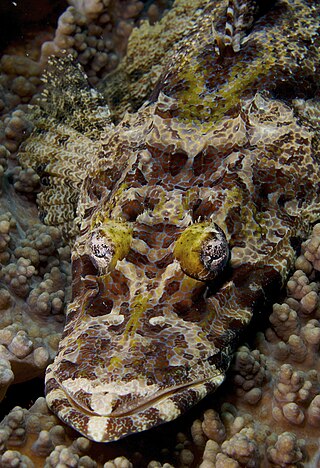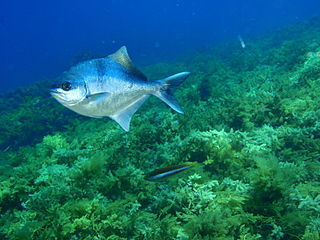
A flathead is one of a number of small to medium fish species with notably flat heads, distributed in membership across various genera of the family Platycephalidae. Many species are found in estuaries and the open ocean in the Indo-Pacific, especially most parts of Australia where they are popular sport and table fish. Flathead can grow at least 1 metre (3.3 ft) in length and 18 kilograms (40 lb) in weight, with dusky flathead being the biggest, although fish this size are seldom caught.

Demersal fish, also known as groundfish, live and feed on or near the bottom of seas or lakes. They occupy the sea floors and lake beds, which usually consist of mud, sand, gravel or rocks. In coastal waters, they are found on or near the continental shelf, and in deep waters, they are found on or near the continental slope or along the continental rise. They are not generally found in the deepest waters, such as abyssal depths or on the abyssal plain, but they can be found around seamounts and islands. The word demersal comes from the Latin demergere, which means to sink.

The bluespotted ribbontail ray is a species of stingray in the family Dasyatidae. Found from the intertidal zone to a depth of 30 m (100 ft), this species is common throughout the tropical Indian and western Pacific Oceans in nearshore, coral reef-associated habitats. It is a fairly small ray, not exceeding 35 cm (14 in) in width, with a mostly smooth, oval pectoral fin disc, large protruding eyes, and a relatively short and thick tail with a deep fin fold underneath. It can be easily identified by its striking color pattern of many electric blue spots on a yellowish background, with a pair of blue stripes on the tail.

Kuhl's maskray, also known as the blue-spotted stingray, blue-spotted maskray, or Kuhl's stingray, is a species of stingray of the family Dasyatidae. It was recently changed from Dasyatis kuhlii in 2008 after morphological and molecular analyses showed that it is part of a distinct genus, Neotrygon. The body is rhomboidal and colored green with blue spots. Maximum disk width is estimated 46.5 cm (18.3 in). It is popular in aquaria, but usually not distinguished from the blue-spotted ribbontail ray. The ribbontail has a rounded body, is a brighter green with brighter blue and more vivid spots, but Kuhl's maskray is larger. The stingray's lifespan is estimated at 13 years for females and 10 years for males. The blue-spotted stingray preys on many fish and small mollusks. It is also generally found from Indonesia to Japan, and most of Australia. Kuhl's maskray also is targeted by many parasites, such as tapeworms, flatworms, and flukes.

The Platycephalidae are a family of marine fish, most commonly referred to as flatheads. They are relatives of the popular lionfish, belonging to the order Scorpaeniformes.

Platycephalus is a genus of mostly marine, demersal ray-finned fish belonging to the family Platycephalidae. They are found in the eastern Mediterranean, the Indian Ocean and western Pacific Ocean.

Platycephalus fuscus, the dusky flathead or black flathead, is a large predatory fish and the largest member of the family Platycephalidae. Dusky flathead are a largely estuarine species and are found in estuaries, estuarine lakes and coastal bays on the east coast of Australia, from Cairns in Queensland to the Gippsland Lakes in Victoria. They occur over sand, mud, gravel and seagrass and can inhabit estuarine waters up to the tidal limit.

De Beaufort's flathead, also known as the crocodilefish or giant flathead, is a species of marine ray-finned fish belonging to the family Platycephalidae, the flatheads. It is found in the Western Pacific Ocean.

Chaetodontoplus caeruleopunctatus, the bluespotted angelfish, is a species of marine ray-finned fish, a marine angelfish belonging to the family Pomacanthidae. It is from the Western-Pacific Ocean.

The bartail flathead, also known as the Indian flathead, gobi or Indo-Pacific flathead, is a species of largely marine ray-finned fish belonging to the family Platycephalidae, the flatheads. This species is found in the Indian Ocean and the Western Pacific Ocean, and has invaded the eastern Mediterranean Sea.

Platycephalus speculator, the southern bluespotted flathead, Castelnau's flathead, deepwater flathead, king flathead, Lakes Entrance flathead, longnose flathead, shovelnose flathead, Southern dusky flathead, Southern flathead or yank flathead, is a common species of flathead. This species is endemic to southern Australia.

Paraplesiops bleekeri, commonly known as the eastern blue devil, blue-tipped long-fin or Bleeker's blue devil fish, is a species of fish in the family Plesiopidae. This colourful, secretive fish is endemic to Australia, where it is a protected species.

The Longhead flathead, also known as the crocodile flathead or weed flathead, is a species of marine ray-finned fish belonging to the family Platycephalidae, the flatheads. This species is endemic to reefs in the coastal waters of southern Australia.

Platycephalus laevigatus, the rock flathead, black flathead, grass flathead, king flathead, marbled-bellied flathead, Port Albert flathead, smooth flathead or Southern rock flathead, is a species of marine ray-finned fish belonging to the family Platycephalidae, the flatheads. This species is endemic to Australia.

The immaculate damselfish, also known as the green puller, is a species of ray-finned fish, it is the only species in the monotypic genus Mecaenichthys, classified in the subfamily Pomacentrinae of the family Pomacentridae.
Microcotyle bassensis is a species of monogenean, parasitic on the gills of a marine fish. It belongs to the family Microcotylidae.

Platycephalus bassensis the Southern sand flathead, Bass flathead, bay flathead, common flathead, sand flathead, sandy, sandy flathead, slimy flathead or yanks, is a species of marine ray-finned fish belonging to the family Platycephalidae, the flatheads. It is endemic to Australia.
Platycephalus endrachtensis, or the bar-tailed flathead, bar-tail flathead, flag-tail flathead, northern sand flathead, northern-flag tailed flathead, sand flathead, western estuary flathead, is a predatory fish in the family Platycephalidae. It is found from the eastern Indian Ocean to the western Pacific, including in Australian and Indonesian waters up to 60 m (200 ft) deep over sand, at temperatures between 17 and 18 °C. The maximum length of the species is 62 cm (24 in), and its weight up to 5 kg (11 lb). A popular angling species, the specific epithet endrachtensis refers to Eendrachtsland, an early Dutch name for Australia, with the suffix -ensis, meaning "place". Venomous spines are hazardous for safe handling.
Inegocia japonica, the Japanese flathead, rusty flathead or smooth flathead, is a species of marine ray-finned fish belonging to the family Platycephalidae, the flatheads. It is found in the Indo-West Pacific region.

The sea sweep, also known as the maomao, snapjack, sweep is a species of marine ray-finned fish from the subfamily Scorpidinae of the sea chub family Kyphosidae. It is native to the southwestern Pacific Ocean from Australia to New Zealand.















